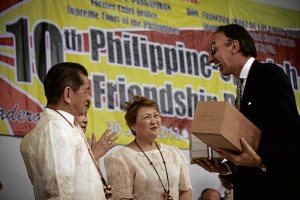
Fireworks capped Philippine-Spanish Friendship Day last June 30 , the national celebration of which took place in Baler, Aurora.
The event was doubly significant since the 10th anniversary of the celebration came alongside the bicentennial commemoration of the Spanish Constitution of 1812.
The Cadiz Constitution of 1812 was Spain’s first constitution. It “recognized” Philippine representation in the Cortes; the secularization of Philippine parishes; Filipino political rights. It restored the Philippines as a province of Spain.
“The Cadiz Constitution served as the basis of early governments and constitutional liberalism in early history,” said retired Chief Justice Artemio Panganiban during the inaugural program in the morning.
Francisco de los Cobos, justice of the Spanish Constitutional Court, traced the history of the Malolos Constitution of 1898, the charter of the First Philippine Republic, to the Cadiz Constitution.
De los Cobos praised the Malolos charter for “consecrating human rights” just like Cadiz had done earlier.
Republic Act No. 9187, authored by Sen. Edgardo Angara, recognizes June 30 of every year as the Philippine-Spanish Friendship Day. It commemorates the act of benevolence of President Emilio Aguinaldo when he issued a decree on June 30, 1899, stating that the 35 soldiers who survived the legendary Siege of Baler be treated as comrades in arms, not prisoners of war.
At the close of the war of independence in 1898, 54 Spaniards—49 soldiers, three officers, one medical officer and a parish priest—barricaded themselves inside the Church of San Luis Obispo de Tolosa in Baler, Aurora.
They holed up in the church, refusing to surrender until June 2, 1899, or after 337 days.
During the yearlong siege, Filipino troops allowed carabaos (water buffalos) to stray into the church grounds, providing food for the Spanish soldiers.
When the dust settled, 35 managed to survive. Five died from gunshot wounds, while 14 died from beriberi and dysentery. When the surviving Spaniards emerged from the church, they received cheers of “Amigos, amigos!” from the Katipuneros and natives of Baler.
Cultural night
The cultural night by the Cultural Center of the Philippines at Sentro Baler featured local and international performers.
Marta Fernandez Portillo, poet and Spanish philologist, did a poetry reading of “Puerto Escondido” (Hidden Port). The poem is one of the many featured in the exhibit “Meridian World,” which chronicles her journey in Galeon Andalucia, being mounted in Museo de Baler, Aurora.
Spanish guitarist Javier Alvarez serenaded the audience with “La Edad del Porvenir” and “Sunset Boulevard.”
Filipina soprano Camille Lopez-Molina sang Nicanor Abelardo’s “Bituing Marikit,” while internationally renowned baritone Andrew Fernando gave a rousing rendition of Maria Grever’s “Jurame.”
Lopez-Molina and Fernando later harmonized for a version of “Makikiliti Kang Totoo,” from Severino Reyes’ sarswela “Walang Sugat.”
Renato Lucas, principal cellist of the Philippine Philharmonic Orchestra and a professor at the University of Santo Tomas Conservatory of Music, performed Abelardo’s “Cavatina” and Isaac Albeniz’s “Asturias.”
On the other hand, Ballet Philippines’ (BP) Candice Adea and Jean Marc Cordero performed “Halik,” an excerpt from the much-praised ballet production “Crisostomo Ibarra.” BP also staged “Lahat ng Araw,” which involved danseurs performing flamenco in bright, red dresses.
Lahing Batangan Dance Troupe from Lyceum University of the Philippines performed the dance suites “Philippine Panorama,” “Jotas Filipinas” and “Flor de Manila.” They danced alongside Ilongot and Dumagat dancers in “Sonrisas de Amistad.”
The Bukidnon State University Chorale awed the audience with “Bukidnon Sketches” and “Ati,” songs which involved imitating animal sounds and uncertain time signatures while being almost devoid of lyrics. They received loud applause from the crowd.
Pop-music sensation Sarah Geronimo performed Louie Ocampo’s “Ngayon, Bukas, at Kailanman,” theme song of the historical movie “Baler.”
Artists Village
Senator Angara said he planned to formally open the Artists Village in Baler, Aurora.
“The village will be similar to the Tam-Awan artist’s village,” he said. “I hope that my son, Sonny Angara, will take up my cause.” (It is expected that Juan Edgardo “Sonny” Angara, a member of the House of Representatives for the lone district of Aurora, will run for the Senate next year.)
The inaugural program in the morning oversaw a wreath-laying ceremony in front of Baler Church, attended by Ambassador Jorge Domecq of Spain; Ambassador Roberto Mayorga Lorca of Chile; Ambassador Prasas Prasasvinitchai of Thailand; Ambassador Joaquin Daniel Otero of Argentina; Ambassador Nguyen Vu Tu of Vietnam; Ambassador Kristiarto Legowo of Indonesia; Ambassador Roberto Carlos Vallarino of Panama; Ambassador Menashe Bar-On of Israel; and Ambassador Saad Zamuna of Libya.
Other members of the diplomatic corps present were Cahamfeuang Phanthaxay, Deputy Chief of Mission of Laos; Jesus Garcia Aldaz of the Spanish Ministry of Foreign Affairs and Cooperation; Maria Molina of the Embassy of Spain; and José Maria Fons-Guardiola, cultural coordinator of Instituto Cervantes.
National Historical Commission of the Philippines chair Maria Serena Diokno was also present.
The inaugural program also witnessed the launching of National Artist for Literature Virgilio Almario’s new book, “Komedya de Baler.”
Later, Museo de Baler opened “Seraphico,” an exhibit of relics such as letters, reports and drawings from the Franciscan missionaries who evangelized Aurora from 1609 to 1899.